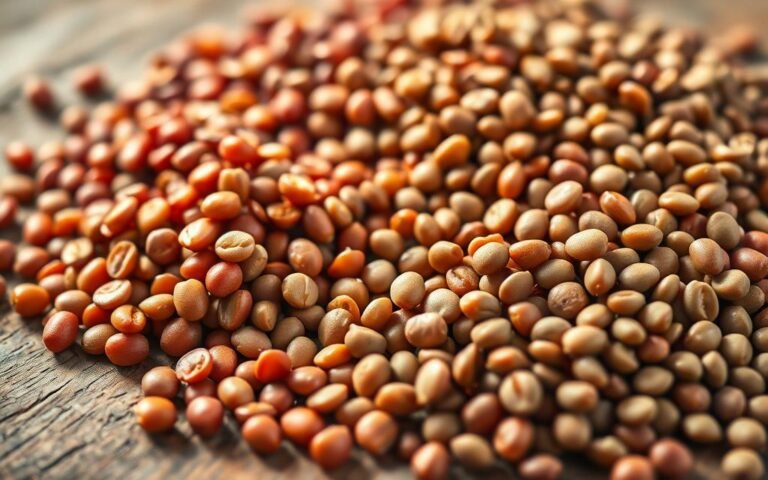Incorporating legumes into your daily diet can be a game-changer for your overall health. Legumes are rich in nutrients, including proteins, fibers, and various vitamins and minerals, making them an excellent addition to a healthy diet.
Eating legumes regularly can help improve heart health, manage blood sugar levels, and even support weight management. With their high nutritional value, legumes are a simple yet effective way to enhance your well-being.
Key Takeaways
- Legumes are rich in nutrients, including proteins and fibers.
- Incorporating legumes daily can improve heart health.
- Legumes can help manage blood sugar levels.
- They support weight management.
- Legumes are a simple addition to a healthy diet.
What Are Legumes? Understanding These Nutritional Powerhouses
Legumes are a diverse group of plants that have been a cornerstone of human nutrition for centuries. They are characterized by their seed pods that split open to reveal their seeds. Legumes are known for their high nutritional value, including proteins, fibers, and various essential vitamins and minerals.
Common Types of Legumes Available in Australia
Australia offers a wide variety of legumes, both locally grown and imported. Understanding the different types can help in incorporating them into daily meals.
Local Australian Legume Varieties
Australia grows several varieties of legumes, including lentils, chickpeas, and fava beans. These are not only nutritious but also support local agriculture.
Imported Legumes Popular in Australian Markets
In addition to local varieties, Australia also imports legumes such as kidney beans, black beans, and pinto beans, offering a diverse range of culinary options.
| Legume Type | Nutritional Highlights | Culinary Uses |
|---|---|---|
| Lentils | High in protein and fiber | Soups, stews, curries |
| Chickpeas | Rich in vitamins and minerals | Hummus, salads, stews |
| Kidney Beans | Excellent source of protein | Chili con carne, salads |
The Historical Significance of Legumes in Human Diet
Legumes have been a staple in human diets for thousands of years, providing essential nutrients during times when other food sources were scarce. Their cultivation has played a significant role in the development of agriculture and human civilization.
The historical significance of legumes is not just in their nutritional value but also in their role in shaping agricultural practices and food cultures around the world.
The Nutritional Profile of Legumes
Legumes are renowned for their dense nutritional content, providing numerous health benefits. They are a staple in many diets around the world, particularly in Australia, where they are valued for their nutritional benefits and versatility in cooking.
Protein Content: A Plant-Based Protein Goldmine
Legumes are an excellent source of plant-based protein, making them ideal for vegetarians and vegans. They contain all the essential amino acids necessary for good health, although some may be low in certain amino acids like methionine. Combining legumes with grains can provide a complete protein profile.
- Lentils offer about 18g of protein per 1 cup cooked.
- Chickpeas provide around 15g of protein per 1 cup cooked.
- Beans, such as kidney or black beans, offer approximately 15g of protein per 1 cup cooked.
Fiber, Vitamins, and Minerals in Legumes
Besides being rich in protein, legumes are also high in dietary fiber, vitamins, and minerals. They are a good source of folate, iron, zinc, and potassium. The high fiber content in legumes supports digestive health and can help lower cholesterol levels.
The fiber in legumes also aids in satiety, making them a valuable component of weight management diets. Moreover, legumes have a low glycemic index, which helps in stabilizing blood sugar levels.
Comparing Nutritional Value Across Different Legumes
Different types of legumes offer varying nutritional benefits. Understanding these differences can help in making informed dietary choices.
Lentils vs. Chickpeas vs. Beans
| Legume Type | Protein Content (g/cup) | Fiber Content (g/cup) |
|---|---|---|
| Lentils | 18 | 16 |
| Chickpeas | 15 | 12 |
| Beans (Kidney) | 15 | 8 |
Australian-Grown vs. Imported Legumes
The nutritional value of legumes can also vary based on whether they are grown locally or imported. Australian-grown legumes are often fresher and may have higher nutritional content due to less transportation time. However, both local and imported legumes can be nutritious, depending on farming practices and storage conditions.
The Benefits of Eating Legumes Daily for Digestive Health
Legumes, when eaten daily, offer substantial advantages for maintaining a healthy digestive system. Incorporating these nutrient-rich foods into your diet can lead to significant improvements in gut health and overall well-being.
How Legumes Support Gut Microbiome Health
Legumes are rich in prebiotic fibers that play a crucial role in supporting gut health. These fibers act as food for the beneficial bacteria in the gut, promoting a healthy gut microbiome.
Prebiotic Properties of Legumes
The prebiotic properties of legumes help in nourishing the good bacteria in the gut, thereby supporting a balanced gut flora. This balance is essential for proper digestion and overall health.
Building a Healthy Gut Flora
A diet rich in legumes can lead to a diverse and thriving gut microbiome. This diversity is linked to better digestive health and a stronger immune system.

Preventing Digestive Disorders with Regular Legume Consumption
Regular consumption of legumes can help prevent various digestive disorders by maintaining a healthy gut. Conditions such as constipation, diverticulitis, and irritable bowel syndrome (IBS) can be managed more effectively with a diet that includes legumes.
Eating legumes daily can also reduce the risk of developing certain gastrointestinal diseases. The fiber content in legumes helps in regulating bowel movements and preventing the onset of these conditions.
Heart Health Advantages of Daily Legume Consumption
Daily consumption of legumes is associated with numerous cardiovascular benefits. Incorporating these nutrient-rich foods into your diet can lead to a healthier heart and reduced risk of cardiovascular diseases.
Cholesterol-Lowering Effects of Legumes
Legumes are known to have a positive impact on cholesterol levels. They are rich in soluble fiber, which helps bind to bile acids and lower LDL (bad) cholesterol. Studies have shown that a diet rich in legumes can significantly reduce total and LDL cholesterol levels, thereby reducing the risk of heart disease.
- Soluble fiber in legumes helps lower LDL cholesterol.
- Regular consumption can reduce the risk of heart disease.
Blood Pressure Regulation and Legumes
Legumes also play a crucial role in regulating blood pressure. They are a good source of potassium, magnesium, and fiber, all of which contribute to maintaining healthy blood pressure levels. Research has indicated that diets high in these nutrients can help mitigate hypertension.
“A diet rich in potassium can help lower blood pressure by balancing out the effects of sodium and promoting healthy blood vessel function.”
Research from Australian Heart Health Organizations
Australian heart health organizations have conducted extensive research on the benefits of legumes. According to their findings, incorporating legumes into your daily diet can significantly improve heart health by reducing cholesterol levels and regulating blood pressure.
Recommended Daily Intake for Cardiovascular Benefits
To reap the cardiovascular benefits of legumes, it is recommended to consume at least one serving (around 150g) daily. This can be achieved by incorporating a variety of legumes into your meals.
By making legumes a staple in your diet, you can take a significant step towards maintaining a healthy heart and overall well-being.
Weight Management and Blood Sugar Control
Legumes, rich in fiber and nutrients, play a significant role in managing weight and stabilizing blood sugar levels. Their unique nutritional profile makes them an ideal food for those looking to improve their overall health.
How Legumes Help You Feel Fuller Longer
The high fiber content in legumes helps to induce a feeling of fullness, reducing the likelihood of overeating. This satiety-inducing effect is crucial for weight management.
Mechanisms behind satiety: The fiber in legumes slows down digestion, keeping you feeling fuller for longer. This mechanism is beneficial for those trying to manage their weight.
Legumes and Glycemic Index: Stabilizing Blood Sugar
Legumes have a low glycemic index, meaning they are digested slowly, preventing a rapid spike in blood sugar levels. This characteristic is particularly beneficial for individuals with diabetes or those trying to manage their blood sugar.
Research on Legumes for Weight Loss and Maintenance
Numerous studies have investigated the role of legumes in weight loss and maintenance. Research indicates that incorporating legumes into one’s diet can lead to significant weight loss and improved overall health.
Australian Studies on Legumes and Obesity Prevention
Australian research has highlighted the potential of legumes in obesity prevention. Studies have shown that diets rich in legumes can reduce the risk of obesity and related health issues.
Incorporating Legumes into Weight Management Plans
Legumes can be easily incorporated into weight management plans. They are versatile and can be used in a variety of dishes, from soups to salads.
The Benefits of Eating Legumes Daily: Scientific Evidence
The health benefits of eating legumes daily have been extensively researched, with scientific evidence mounting in favor of this dietary habit. Studies have shown that incorporating legumes into one’s daily diet can lead to significant health improvements.
Long-term Studies on Daily Legume Consumption
Long-term studies have provided valuable insights into the effects of daily legume consumption. Research has indicated that regular consumption of legumes can lead to reduced risks of chronic diseases such as heart disease and diabetes.
A notable study published in a reputable journal found that participants who consumed legumes daily over a period of several years experienced improved cardiovascular health compared to those who did not.
Recommended Daily Amounts for Optimal Health Benefits
Understanding the optimal daily amount of legume consumption is crucial for maximizing health benefits. Guidelines suggest that adults should aim to consume a certain amount daily.
Australian Dietary Guidelines on Legumes
The Australian Dietary Guidelines recommend including a variety of legumes in the diet. According to these guidelines, legumes are a key component of a healthy eating pattern.
Practical Measurement Guidelines for Daily Intake
To simplify daily legume consumption, practical measurement guidelines are provided below:
| Legume Type | Serving Size | Daily Recommendation |
|---|---|---|
| Lentils | 1/2 cup cooked | 1 serving |
| Chickpeas | 1/2 cup cooked | 1 serving |
| Kidney Beans | 1/2 cup cooked | 1 serving |

By following these guidelines and incorporating legumes into daily meals, individuals can reap the numerous health benefits associated with legume consumption.
Legumes for Bone Health and Longevity
As a nutrient-dense food group, legumes offer numerous benefits for bone health and can contribute to a longer, healthier life. The role of legumes in supporting overall health is multifaceted, with significant advantages for both bone density and longevity.
Calcium, Magnesium, and Other Bone-Supporting Nutrients
Legumes are rich in essential nutrients that are vital for maintaining strong bones. Calcium and magnesium are particularly important, as they support bone density and reduce the risk of osteoporosis. According to a study published on Medical News Today, legumes are a good source of these minerals, making them an excellent addition to a bone-healthy diet.
| Legume Type | Calcium Content (mg per 100g) | Magnesium Content (mg per 100g) |
|---|---|---|
| Lentils | 24 | 122 |
| Chickpeas | 105 | 115 |
| Kidney Beans | 27 | 140 |
Anti-Aging Benefits of Regular Legume Consumption
Regular consumption of legumes has been associated with various anti-aging benefits, contributing to overall longevity. The high fiber and antioxidant content in legumes help in reducing inflammation and oxidative stress, factors that are known to accelerate aging.
Legumes in Traditional Longevity Diets
Traditionally, legumes have been a staple in diets known for promoting longevity, such as the Mediterranean diet. These diets emphasize plant-based foods, including a variety of legumes, which are believed to contribute to the observed health benefits and increased lifespan in populations adhering to these dietary patterns.
Modern Research on Legumes and Aging
Modern research supports the traditional views on legumes and longevity. Studies have shown that the consumption of legumes is associated with reduced mortality rates and improved health outcomes in older adults. A
“diet rich in legumes can contribute to healthy aging by providing essential nutrients and bioactive compounds that mitigate age-related diseases.”
Incorporating legumes into your diet can be a simple yet effective way to support bone health and promote longevity. With their rich nutritional profile and versatility in cooking, legumes are an ideal food group for those looking to adopt a healthier lifestyle.
Environmental Benefits of Choosing Legumes in Australia
Embracing daily legumes is a simple yet effective way to reduce your carbon footprint and promote sustainable farming in Australia. The environmental benefits of legume consumption are multifaceted, ranging from sustainable production practices to reduced water usage.
Sustainability of Australian Legume Production
Australian legume production is known for its sustainability. Legumes are typically grown using crop rotation practices, which enhance soil health and reduce the need for synthetic fertilizers. This approach not only improves soil fertility but also supports biodiversity.
Reducing Carbon Footprint Through Plant-Based Protein Sources
Choosing plant-based protein sources like legumes can significantly reduce an individual’s carbon footprint. Legume cultivation generally produces lower greenhouse gas emissions compared to animal-based protein production. By incorporating daily legumes into your diet, you’re contributing to a reduction in overall carbon emissions.
Water Conservation in Legume Farming
Legume farming is relatively water-efficient, especially when compared to other protein sources. Many Australian legume farmers employ advanced irrigation techniques to minimize water waste, further enhancing the sustainability of legume production.
Supporting Local Australian Legume Farmers
By choosing Australian-grown legumes, consumers are directly supporting local farmers and contributing to the local economy. This support encourages the continuation of sustainable farming practices and promotes food security.
Overcoming Digestive Discomfort: Making Legumes Work for You
While legumes offer numerous health benefits, some individuals experience digestive issues after consuming them. This discomfort can be a significant barrier to incorporating these nutritional powerhouses into one’s diet.
Why Legumes Cause Gas and Bloating for Some People
Legumes contain certain carbohydrates that can be difficult for some people to digest, leading to gas and bloating. These carbohydrates are not fully broken down in the small intestine and are instead fermented by bacteria in the large intestine, producing gas.
Preparation Techniques to Reduce Antinutrients
Certain preparation techniques can significantly reduce the antinutrients in legumes, making them easier to digest. Two effective methods are soaking and cooking.
Soaking Methods
Soaking legumes before cooking can help reduce their phytic acid content, an antinutrient that can inhibit mineral absorption. Overnight soaking or using a quick soak method can be effective.
Cooking Techniques
Cooking legumes thoroughly is crucial. Pressure cooking is particularly effective as it not only reduces cooking time but also helps in breaking down some of the indigestible carbohydrates.
Gradually Introducing Legumes to Your Diet
To minimize digestive discomfort, it’s advisable to introduce legumes into your diet gradually. Start with small portions and gradually increase the amount over time, allowing your gut microbiome to adjust.
By understanding the causes of digestive discomfort and employing simple preparation techniques, you can enjoy the legume benefits while maintaining digestive comfort.
How to Incorporate Legumes Into Your Daily Australian Diet
Incorporating legumes into your daily diet can be simple and delicious with these Australian-inspired recipe ideas. Legumes are a versatile ingredient that can enhance the nutritional value of various meals. With a focus on breakfast, lunch, dinner, and even snacks and desserts, you can easily make legumes a staple in your diet.
Breakfast Ideas with Legumes
Starting your day with legumes can be both nutritious and delicious. Here are a couple of ideas:
Australian-Style Baked Beans on Toast
A classic breakfast option, Australian-style baked beans on toast is a simple way to include legumes in your morning meal. Use whole-grain bread and add some fresh tomatoes for extra nutrition.
Chickpea Breakfast Bowls
Create a chickpea breakfast bowl by mixing cooked chickpeas with diced vegetables, a squeeze of lemon juice, and a sprinkle of feta cheese. Serve over quinoa or whole-grain toast for a filling breakfast.
Lunch and Dinner Legume Recipes
Legumes can be the star of your lunch and dinner dishes, offering a boost of protein and fiber. Consider these ideas:
Lentil and Vegetable Salads
Combine cooked lentils with a variety of roasted vegetables, such as sweet potatoes and Brussels sprouts, and a tangy dressing for a healthy salad.
Bean-Based Main Dishes
Use beans as the base for main dishes like chili con carne or vegetarian bean stews. These are not only flavorful but also packed with nutrients.
Snacks and Desserts Using Legumes
Legumes aren’t just for savory dishes; they can also be used in sweet treats and healthy snacks.
For a unique dessert, try making a black bean brownie by blending cooked black beans with cocoa powder, eggs, and sugar, then baking into a rich, fudgy treat. For snacks, roasted chickpeas seasoned with herbs and spices make a crunchy, satisfying option.
| Meal | Legume-Based Dish | Nutritional Highlights |
|---|---|---|
| Breakfast | Australian-Style Baked Beans on Toast | High in fiber, protein |
| Lunch/Dinner | Lentil and Vegetable Salad | Rich in vitamins, minerals, and antioxidants |
| Dessert | Black Bean Brownies | Good source of fiber, protein, and iron |
Legumes for Special Populations in Australia
Legumes offer a multitude of health benefits that cater to various age groups and special populations in Australia. Their nutritional profile makes them an ideal food for different life stages.
Benefits for Children and Adolescents
For children and adolescents, legumes provide essential nutrients like protein, fiber, and various vitamins and minerals that support growth and development. Incorporating legumes into their diet can help establish healthy eating habits from a young age.
Legumes During Pregnancy and Breastfeeding
During pregnancy and breastfeeding, legumes can be particularly beneficial due to their high folate content, which is crucial for fetal development. They also provide a good source of iron, helping to prevent anemia.
Legumes for Older Adults
For older adults, legumes are a valuable source of nutrition, offering protein, fiber, and minerals that support heart health and can help manage conditions like diabetes.
Supporting Aging Health with Legume Nutrition
Legumes can play a significant role in supporting the health of older adults by providing nutrients that help maintain muscle mass and bone density.
Easy-to-Prepare Legume Dishes for Seniors
Simple legume-based dishes, such as lentil soup or chickpea salad, can be easily prepared and are nutritious options for seniors.
| Life Stage | Benefits of Legumes | Examples of Legumes |
|---|---|---|
| Children and Adolescents | Supports growth and development | Kidney beans, chickpeas |
| Pregnancy and Breastfeeding | High in folate, prevents anemia | Lentils, black beans |
| Older Adults | Supports heart health, manages diabetes | Split peas, lima beans |
Addressing Common Myths and Concerns About Daily Legume Consumption
Despite the nutritional benefits, some concerns and myths surround the daily intake of legumes. As people incorporate more legumes into their diets, it’s essential to address these misconceptions to ensure a balanced understanding.
Are Legumes Suitable for Low-Carb Diets?
Legumes are often misunderstood in the context of low-carb diets. While they do contain carbohydrates, they are also rich in fiber and protein, making them a nutritious choice. Moderation is key; a serving of legumes can be part of a balanced low-carb meal plan.
Legumes and Antinutrients: Separating Fact from Fiction
Legumes contain antinutrients like phytates, which can affect mineral absorption. However, soaking, boiling, or fermenting legumes can significantly reduce these compounds. The benefits of legume consumption far outweigh the risks when properly prepared.
Allergies and Intolerances to Consider
Some individuals may experience allergic reactions or intolerance to legumes. It’s crucial to be aware of the symptoms, such as bloating or hives, and consult a healthcare professional if concerns arise.
| Myth | Fact |
|---|---|
| Legumes are not suitable for low-carb diets. | Legumes can be part of a low-carb diet when consumed in moderation. |
| Antinutrients in legumes are harmful. | Proper preparation reduces antinutrients, making legumes safe and nutritious. |
Conclusion: Making Legumes a Sustainable Part of Your Healthy Lifestyle
Incorporating legumes into your daily diet can have a significant impact on your overall health and wellbeing. As discussed throughout this article, the benefits of eating legumes daily are numerous, ranging from improved digestive health to a reduced risk of chronic diseases.
By making legumes a staple in your diet, you can adopt a more sustainable lifestyle that not only benefits your health but also the environment. Legumes are a nutrient-rich food that can be incorporated into a variety of dishes, from traditional Australian meals to innovative, plant-based recipes.
To maintain a legume-rich diet, explore different types of legumes, experiment with new recipes, and make informed choices about the products you buy. By doing so, you can enjoy the many benefits of legumes while contributing to a more sustainable food system.





